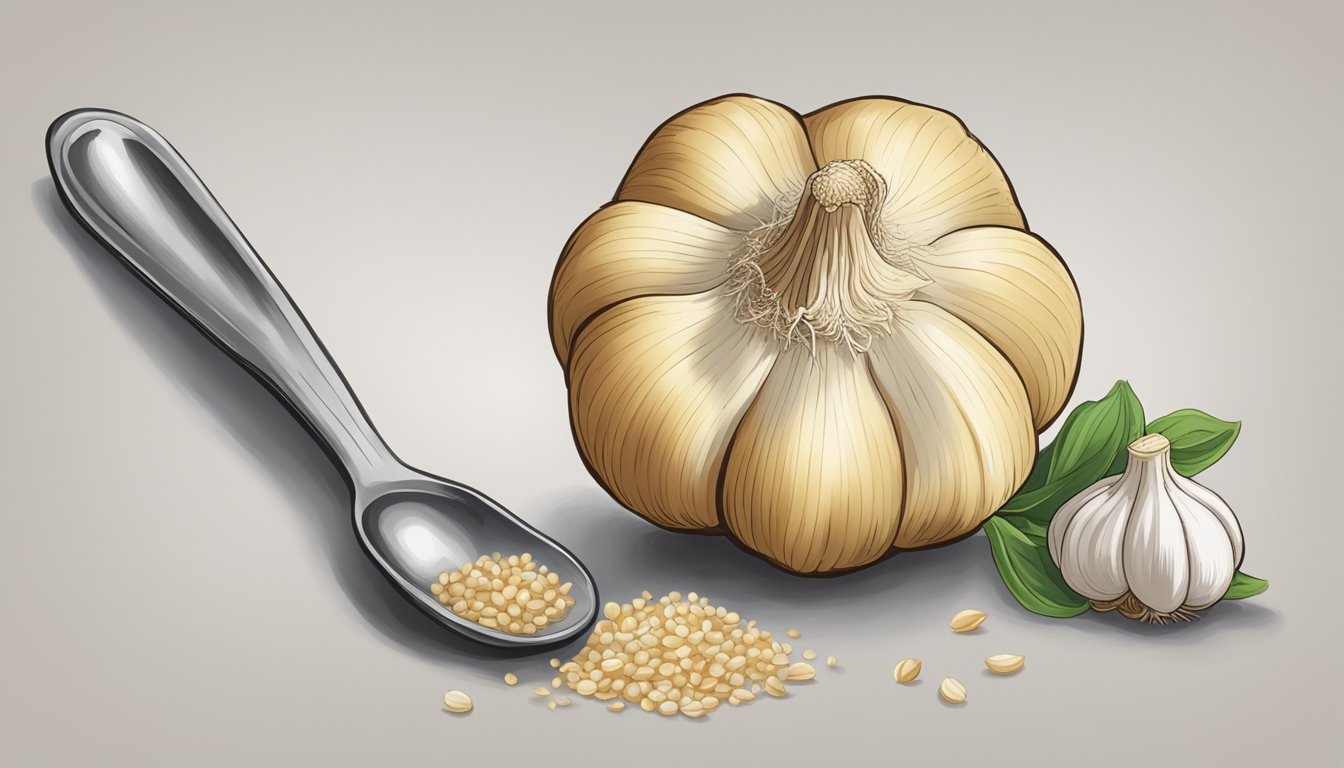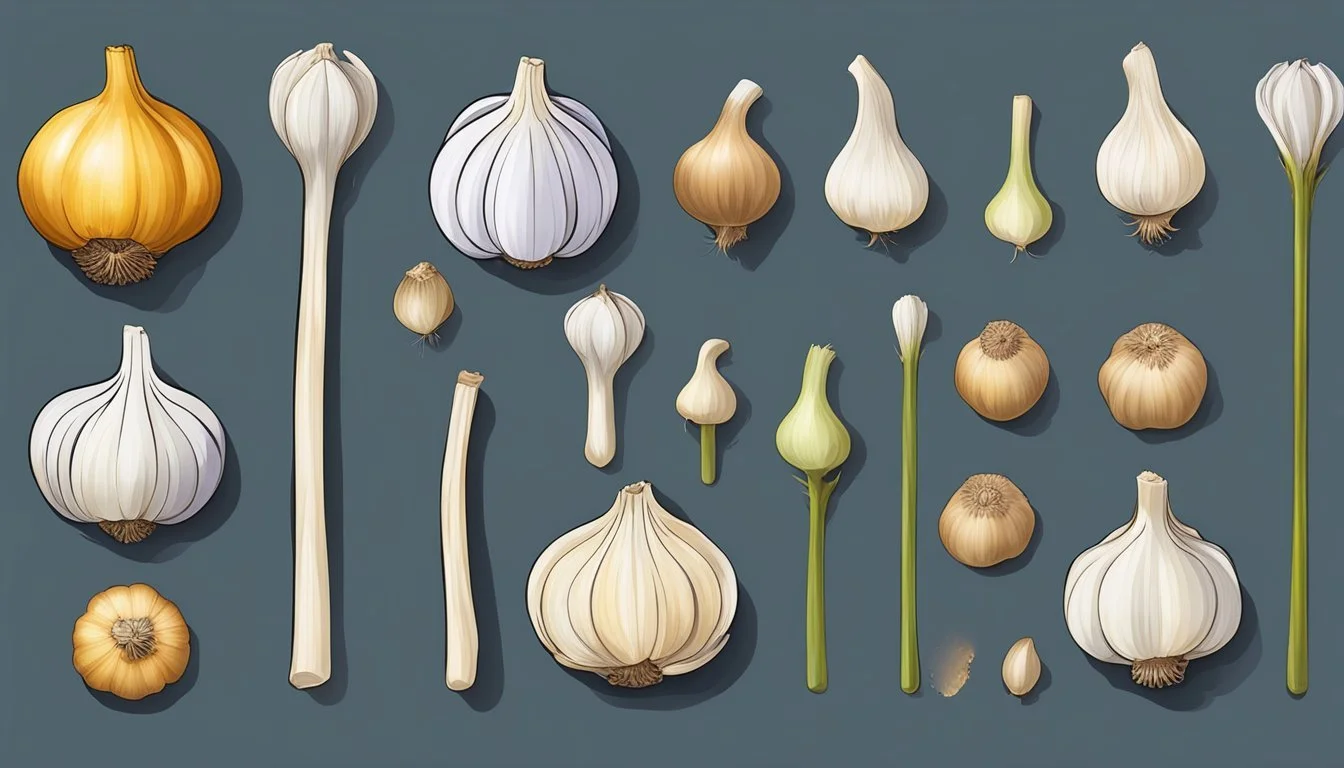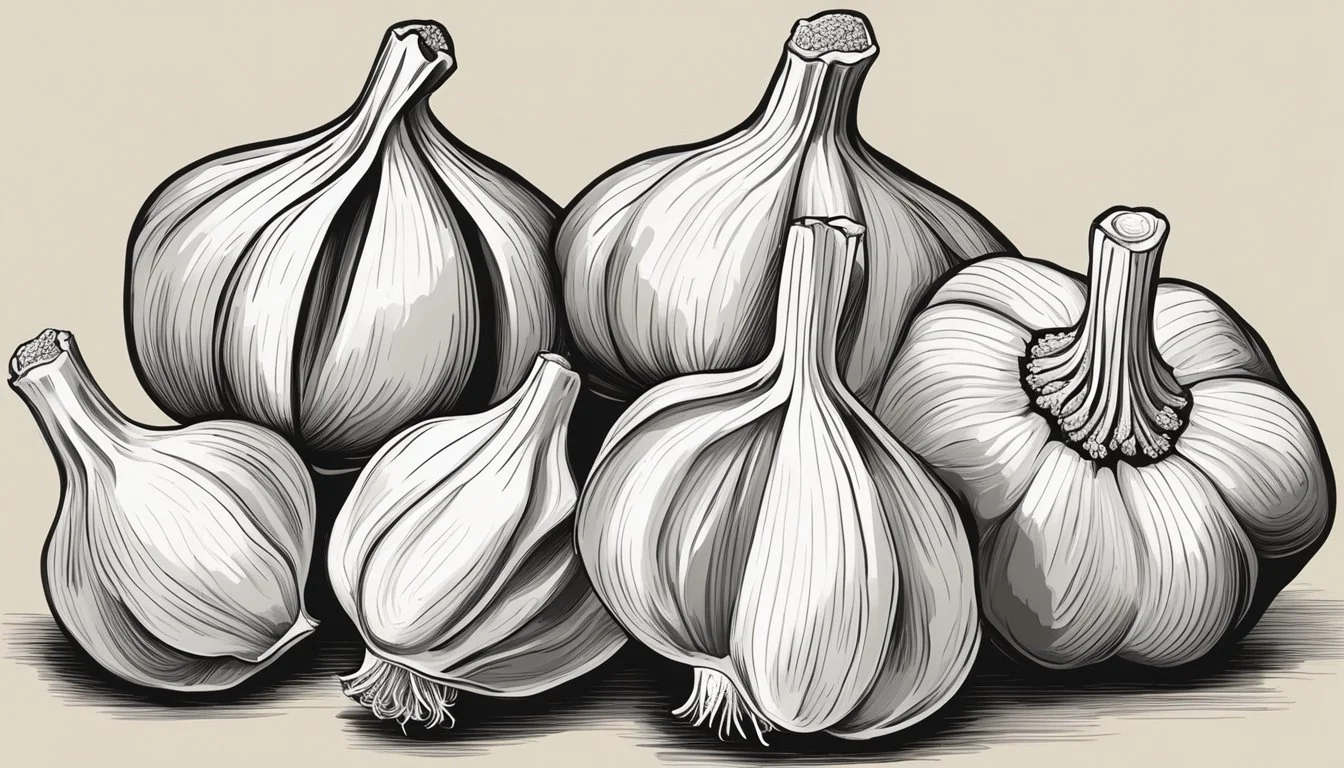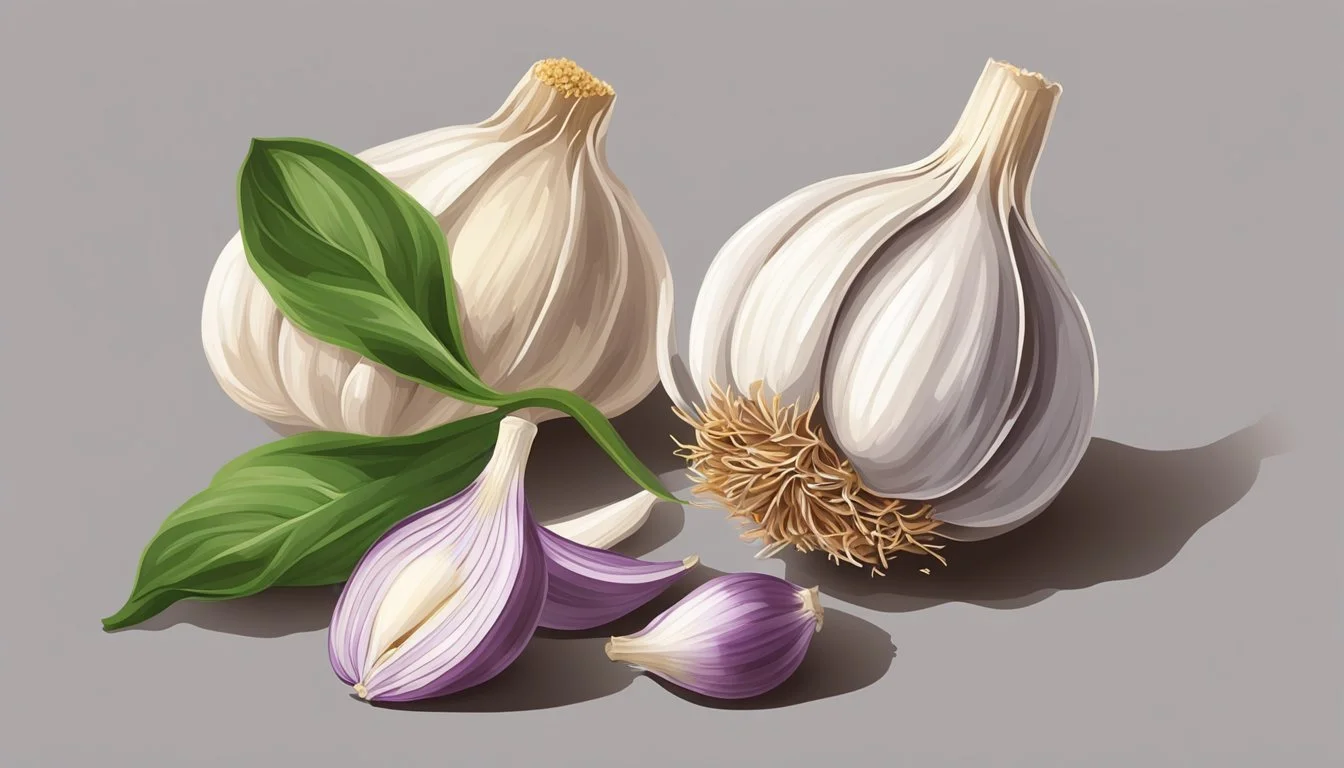How Many Tablespoons in a Clove of Garlic
Measuring Garlic Quantities Accurately
When cooking, the precise measurement of ingredients is crucial to achieving the desired flavor and texture of a dish. Garlic (What wine goes well with garlic?), a common and beloved ingredient in myriad cuisines, often prompts the question of how to convert its cloves to more standard measurements. A clove of garlic is a small, irregularly shaped bulb that can be minced or crushed when adding its potent flavor to dishes. The conversion from cloves to tablespoons can depend on the clove's size, yet an average clove of garlic typically equates to about one teaspoon of minced garlic.
Guides for kitchen conversions simplify the process of translating the potency of garlic into tangible measurements for recipes. Most culinary resources agree that it takes about three average-sized cloves of garlic to fill a tablespoon when minced. This guideline serves as a useful starting point, but cooks should account for variation in clove size and personal taste preferences. Some may prefer a subtler hint of garlic, while others might enjoy a more pronounced garlic presence in their cuisine.
Understanding the conversion between cloves of garlic and tablespoons is valuable for both seasoned cooks and newcomers to the kitchen. This knowledge allows for the adaptation of a recipe's garlic content to the cook's preference, having a significant impact on the final taste of a dish. Whether a recipe calls for a subtle hint or a bold burst of garlic, knowing the approximate measure helps ensure culinary success.
Understanding Garlic Measurements
When cooking with garlic, accurate measurements are crucial for the intended flavor profile. This section explains how to convert garlic cloves to tablespoons and discusses the basics of measuring garlic effectively.
Conversion Basics
Garlic measurements can be confusing due to variability in clove size. One clove of garlic generally contains enough minced garlic to equal about one teaspoon. To measure garlic accurately, chefs should consider the physical size of the clove, as there is no absolute standard that applies universally.
Clove to Tablespoon Conversion
When converting from cloves to tablespoons, the guideline is straightforward:
1 clove of garlic is approximately equal to 1 teaspoon of minced garlic.
Therefore, 3 cloves would be needed to fill a 1 tablespoon measure.
Here's a simple reference table for conversions:
Cloves of Garlic Minced Garlic 1 1 teaspoon 3 1 tablespoon
Keep in mind that these are approximate measures, and the actual volume may vary slightly based on the size of the cloves.
Types of Garlic and Their Sizes
Garlic is a culinary staple, and its type greatly influences the amount of yield from each clove. Notably, the size and type of garlic determine the volume of minced garlic one can extract.
Common Varieties of Garlic
Hardneck Garlic: Reputed for fewer but larger cloves, hardneck garlic is known for its strong flavor profile. This type often features in gourmet cooking and is easier to peel.
Size: The cloves tend to be uniform and can be quite large.
Culinary Note: A single large hardneck clove can yield approximately 1 tablespoon of minced garlic.
Softneck Garlic: A more common supermarket variety, softneck garlic usually has more cloves per bulb, which can be smaller in size compared to hardneck.
Size: Smaller, more numerous cloves, which might result in requiring a couple more for a recipe that specifies a tablespoon of garlic.
Elephant Garlic: Despite its name, it is more closely related to leeks. Elephant garlic is prized for its milder flavor and significantly larger size.
Size: Its cloves can dwarf standard garlic, with one clove potentially equaling multiple tablespoons once minced.
Garlic Size Comparisons
Garlic Type Average Clove Size Yield (Minced) Hardneck Garlic Large ~1 tablespoon/clove Softneck Garlic Small to Medium ~1/2 tablespoon/clove Elephant Garlic Extra-Large Varies; often 2+ tablespoons/clove
For fresh garlic, size can vary even within the same variety, affecting the conversion between cloves of garlic and tablespoons when cooking. It is pivotal for chefs to consider these variances and adjust their recipes accordingly.
Preparing Garlic for Cooking
When preparing garlic for cooking, the approach one takes can affect the intensity and distribution of flavor. The use of proper tools like a knife and specific techniques for peeling, chopping and crushing are essential for ideal preparation.
Peeling and Chopping Techniques
To peel a garlic clove, one can gently crush it under the flat side of a knife to loosen the skin. Then, the skin can usually be removed with ease. Subsequently, to proceed with chopping, one should place the peeled clove on a cutting board and make precise cuts with a sharp knife. Chopped garlic is generally coarser and will release a milder flavor compared to minced garlic when cooked.
Techniques for Peeling:
Crush clove slightly with knife's flat side.
Remove the loosened skin.
Techniques for Chopping:
Use a sharp knife for careful, even cuts.
Aim for uniform pieces for consistent cooking.
Crushing and Mincing Fundamentals
To crush garlic, one may use either a garlic press or the flat side of a knife. The act of crushing breaks down the garlic, releasing more of its natural oils and often resulting in a stronger flavor. For mincing, which produces very fine pieces of garlic, a sharp knife is again utilized to finely dice the peeled cloves. Mincing garlic allows for a more intense flavor and even distribution throughout a dish.
Crushing Garlic:
Use a garlic press or knife.
Results in fuller flavor due to release of oils.
Mincing Garlic:
Achieved by finely dicing peeled cloves.
Provides intense flavor and blends well in dishes.
Garlic in Recipes
In cooking, garlic is celebrated for its ability to enhance both flavor and aroma in a diverse array of recipes. It is common to adjust the quantity of garlic used in a recipe to cater to palates ranging from mild to intensely robust.
Adjusting Garlic Quantities
When it comes to adjusting garlic in recipes, one must consider that a single clove of garlic typically equates to about 1/2 to 1 teaspoon when minced. Chefs may vary the amount of garlic based on the desired intensity of flavor:
Mild Taste: 1/2 teaspoon (minced) per clove
Moderate Taste: 3/4 teaspoon (minced) per clove
Strong Taste: 1 teaspoon (minced) per clove
Note: This is a guideline and chefs often adjust to preference.
Garlic Flavor and Aroma
Garlic's flavor and aroma become more pronounced with cooking methods and duration. When raw, it has a sharp, pungent taste. Cooking garlic mellows its bite and releases its aromatic qualities:
Sautéed: Yields a milder flavor, ideal for sauces or stir-fries.
Roasted: Develops sweet, caramelized notes, often used in pastas or spreads.
Fresh garlic cloves significantly influence a dish's depth of flavor, whether minced, pressed, or used whole. Chefs should consider the state and amount of garlic to achieve the perfect balance for their recipe.
Substitutes for Fresh Garlic
When fresh garlic is not available or convenient, various substitutes offer similar flavor profiles suitable for most recipes. These alternatives include garlic powder and granulated garlic, jarred and pre-minced garlic, and other flavorings that can mimic garlic's pungent taste.
Garlic Powder and Granulated Garlic
Garlic Powder: A potent and fine substance, garlic powder is best used in small quantities. For every fresh garlic clove, one should use 1/8 teaspoon of garlic powder.
Granulated Garlic: Less finely ground than powder, granulated garlic provides a somewhat coarser texture. 1/4 teaspoon can replace each clove of fresh garlic.
Jarred and Pre-Minced Garlic
Jarred Minced Garlic: Convenient and ready to use, jarred minced garlic is a time-saving substitution. Approximately 1/2 teaspoon is equivalent to one clove of fresh garlic.
Garlic Paste: Often found in tubes, garlic paste has a smooth consistency and intense flavor. A small taste test is recommended before using, with 1 teaspoon commonly equating to a single clove of garlic.
Alternative Flavorings
Garlic Salt: A mix of garlic powder and salt, garlic salt should be used with care to avoid over-salting a dish. To substitute for a clove of garlic, 1/2 teaspoon of garlic salt is suitable, but it's essential to reduce any additional salt in the recipe by approximately 3/8 teaspoon to maintain the desired seasoning balance.
Storing and Preserving Garlic
When storing garlic, one should be aware of the importance of proper conditions to extend its shelf life. The two viable methods for storage are airtight containers with refrigeration and freezing.
Airtight Containers and Refrigeration
One should avoid storing garlic in airtight containers at room temperature as it can encourage mold growth and sprouting. Instead, individual peeled cloves can be submerged in oil and stored in an airtight container in the refrigerator. It is crucial to use the garlic-oil mixture promptly to prevent the risk of botulism; typically within a week.
Freezing Garlic for Longevity
Freezing is a practical approach for preserving garlic's longevity. Whole unpeeled heads or individual cloves can be placed in freezer bags. To freeze peeled cloves:
Spread them out on a baking sheet.
Cover with plastic wrap.
Freeze until solid.
Transfer the frozen cloves to a freezer-safe container or bag. Frozen garlic can be used directly in cooking and can last indefinitely, although it is optimal to use it within a year for the best flavor. Frozen garlic retains its flavor but may acquire a mushy texture once thawed.
Measurement Tools and Techniques
Accurate measurement is crucial for cooking, especially when dealing with potent ingredients like garlic. Ensuring uniformity and precision in the kitchen requires the right tools and techniques.
Accurate Kitchen Measuring Instruments
Teaspoons and Tablespoons: Essential for any kitchen, teaspoons and tablespoons provide a standard measure for small quantities of ingredients. They ensure that cooks can follow recipes with accuracy. Since one clove of garlic is approximately one teaspoon when minced, using these spoons is the easiest way to maintain consistency.
Digital Scales: For those who seek precision, a digital kitchen scale can measure ingredients by weight. Although not commonly used for garlic alone, it can be helpful when recipes call for larger quantities of minced garlic.
Garlic Press: While not a measuring tool per se, a garlic press ensures uniform mincing of garlic cloves, which contributes to more consistent measuring when using spoons.
Using these tools helps cooks accurately convert the quantity of garlic cloves into tablespoons, capitalizing on uniformity and precision for recipe success.
Converting Garlic Measurements to Weight
When cooking with garlic, it may be necessary to convert volumetric measurements to weight for accuracy, especially when recipes require precise ingredient ratios.
Weight Conversions for Recipes
Different preparation methods of garlic can alter its weight. Typically, one clove of garlic weighs about 3 to 5 grams. Here's a simple reference for how much some common garlic measurements weigh:
1 clove of garlic: 3 to 5 grams
1 teaspoon of minced garlic: about 2.8 grams
1 tablespoon of minced garlic: roughly 8.4 grams
It is important for chefs and home cooks alike to consider the weight of garlic when using it in recipes that are sensitive to ingredient proportions.
Volumetric to Weight Conversion
To convert volume to weight for garlic, use the following approximations:
Volume (Minced Garlic) Approx. Weight in Grams 1 teaspoon 2.8 grams 1 tablespoon 8.4 grams 1/4 cup 42 grams 1/2 cup 84 grams
These estimations assume that one is working with a standard U.S. measurement system where there are 3 teaspoons in a tablespoon and 48 teaspoons in a cup. It’s important for individuals to adjust the weight based on the specific type of garlic preparation used, as the weight can vary slightly between minced, crushed, or chopped garlic.
Unique Aspects of Garlic
Garlic boasts a robust flavor profile that significantly enhances dishes, making it a versatile ingredient in various culinary traditions. Its potent taste and aroma render it indispensable in creating depth and complexity in recipes.
Culinary Uses Across Different Cuisines
Garlic's influence in cooking is global, serving as a cornerstone for flavor in countless dishes. In Italian cuisine, pasta dishes often feature garlic, not merely as a secondary flavor but as a star, imparting a rich and aromatic character that is both bold and comforting. Garlic is fundamental in creating the base for sauces like tomato-based marinara or garlic-infused aglio e olio.
In Asian culinary traditions, garlic plays a pivotal role in stir-fry recipes. Whether it's a vegetable stir-fry (What Wine Pairs Perfectly With Vegetable Stir-Fry?) or a protein-centered dish, garlic adds a piquant and earthy essence that complements the high-heat cooking method. Stir-fries often start with garlic heated in oil, releasing its flavor, and setting the stage for the rest of the ingredients.
Across the diverse uses of garlic, its application is both broad and nuanced, speaking to its adaptability as an ingredient. It can be used raw, roasted, sautéed, or as part of a spice blend, each method unlocking different aspects of its flavor profile. This adaptability is what makes garlic a cherished component in kitchens around the world.
Health Benefits of Garlic
Garlic is a remarkable ingredient that offers significant health benefits to those who include it in their diet. Its unique compounds and nutritional profile contribute to various wellness outcomes.
Nutritional Value and Wellness
The nutritional composition of garlic makes it a valuable addition to the home cook's pantry. A single clove of garlic contains approximately:
Calories: 4
Protein: 0.2 grams
Fat: 0 grams
Carbohydrates: 1 gram
Fiber: 0 grams
Further, garlic is enriched with vitamins and minerals, including:
Vitamin C
Zinc
Iron
Potassium
Calcium
Magnesium
Vitamin K
Regular consumption of garlic can offer the following health benefits:
Reduction in cholesterol levels, particularly low-density lipoprotein (LDL), which is known to clog blood vessels and increase the risk of stroke and heart attacks.
The presence of allicin substances, which are linked to better heart health and potentially lowered blood pressure.
The potential to strengthen the immune system due to its nutrients, like vitamin C and zinc, that are essential for immune function.
By incorporating garlic into meals, not only can a home cook enhance the flavors of their dishes, but they can also contribute positively to their overall health. It is the subtle presence of garlic in daily cooking that can make a difference, with the cumulative effects of its nutritional constituents promoting wellness over time.










